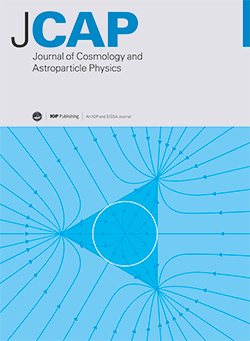Cosmological constraints from the Minkowski functionals of the BOSS CMASS galaxy sample
IF 5.3
2区 物理与天体物理
Q1 ASTRONOMY & ASTROPHYSICS
Journal of Cosmology and Astroparticle Physics
Pub Date : 2025-05-22
DOI:10.1088/1475-7516/2025/05/064
引用次数: 0
Abstract
For the first time, we develop a simulation-based model for the Minkowski functionals (MFs) of large-scale structure, which allows us to extract the full information available from the MFs (including both the Gaussian and non-Gaussian part), and apply it to the BOSS DR12 CMASS galaxy sample. Our model is based on high-fidelity mock galaxy catalogs constructed from the AbacusSummit simulations using the halo occupation distribution (HOD) framework, which include the redshift-space distortions and Alcock-Paczynski distortions, incorporate survey realism, including survey geometry and veto masks, and account for angular plus radial selection effects. The cosmological and HOD parameter dependence of the MFs is captured with a neural network emulator trained from the galaxy mocks with various cosmological and HOD parameters. To benchmark the constraining power of the MFs, we also train an emulator for the galaxy 2-point correlation function (2PCF) using the same pipeline. Having validated our approach through successful parameter recovery tests on both internal and external mocks, including non-HOD forward models of the halo-galaxy connection, we apply our forward model to analyze the CMASS data in the redshift range 0.45 < z < 0.58. We find the MFs provide stronger constraints on the cosmological parameters than the 2PCF. The combination of the two gives ωcdm = 0.1172+0.0020-0.0023, σ8 = 0.783± 0.026, and ns = 0.966+0.019-0.015, which are tighter by a factor of 2.0, 1.9, and 1.6 than the 2PCF alone. The derived constraint fσ8 = 0.453 ± 0.016 is also improved by a factor of 1.9, compared to the 2PCF, and agrees well with Planck 2018 predictions and other results from a series of studies in the literature. This work provides a new methodology for the application of the MFs to galaxy surveys and demonstrates that non-Gaussian information embedded in the MFs can be exploited to obtain strong constraints on cosmological parameters.BOSS CMASS星系样本Minkowski泛函的宇宙学约束
本文首次建立了基于模拟的大尺度结构Minkowski泛函(MFs)模型,该模型允许我们从MFs中提取全部可用信息(包括高斯和非高斯部分),并将其应用于BOSS DR12 CMASS星系样本。我们的模型基于AbacusSummit模拟构建的高保真模拟星系目录,该模拟使用光环占据分布(HOD)框架,其中包括红移空间扭曲和alcouck - paczynski扭曲,结合了巡天真实性,包括巡天几何和veto掩模,并考虑了角度和径向选择效应。利用神经网络仿真器从具有不同宇宙学和HOD参数的星系模型中训练得到MFs的宇宙学和HOD参数依赖关系。为了对MFs的约束能力进行基准测试,我们还使用相同的管道训练了星系2点相关函数(2PCF)的模拟器。通过在内部和外部模型(包括晕星系连接的非hod前向模型)上成功的参数恢复测试验证了我们的方法,我们应用我们的前向模型分析了红移范围为0.45 < z < 0.58的CMASS数据。我们发现MFs比2PCF对宇宙学参数提供了更强的约束。二者结合得到ωcdm = 0.1172+0.0020-0.0023, σ8 = 0.783±0.026,ns = 0.966+0.019-0.015,分别比单独的2PCF紧密2.0、1.9和1.6倍。推导出的约束fσ8 = 0.453±0.016也比2PCF提高了1.9倍,与普朗克2018预测和其他一系列文献研究的结果非常吻合。这项工作为MFs在星系调查中的应用提供了一种新的方法,并证明嵌入在MFs中的非高斯信息可以被利用来获得对宇宙学参数的强约束。
本文章由计算机程序翻译,如有差异,请以英文原文为准。
求助全文
约1分钟内获得全文
求助全文
来源期刊

Journal of Cosmology and Astroparticle Physics
地学天文-天文与天体物理
CiteScore
10.20
自引率
23.40%
发文量
632
审稿时长
1 months
期刊介绍:
Journal of Cosmology and Astroparticle Physics (JCAP) encompasses theoretical, observational and experimental areas as well as computation and simulation. The journal covers the latest developments in the theory of all fundamental interactions and their cosmological implications (e.g. M-theory and cosmology, brane cosmology). JCAP''s coverage also includes topics such as formation, dynamics and clustering of galaxies, pre-galactic star formation, x-ray astronomy, radio astronomy, gravitational lensing, active galactic nuclei, intergalactic and interstellar matter.
 求助内容:
求助内容: 应助结果提醒方式:
应助结果提醒方式:


